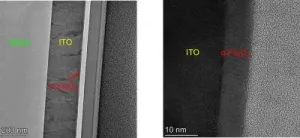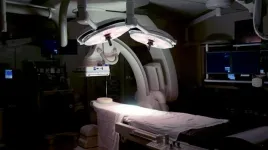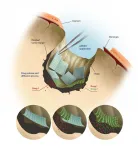Green hydrogen: "Rust" as a photoanode and its limits
Metal oxides such as rust are intriguing photoelectrode materials for the production of green hydrogen with sunlight. They are cheap and abundant, but in spite of decades of research, progress has been limited.
2021-04-19
(Press-News.org) Hydrogen will be needed in large quantities as an energy carrier and raw material in the energy system of the future. To achieve this, however, hydrogen must be produced in a climate-neutral way, for example through so-called photoelectrolysis, by using sunlight to split water into hydrogen and oxygen. As photoelectrodes, semiconducting materials are needed that convert sunlight into electricity and remain stable in water. Metal oxides are among the best candidates for stable and inexpensive photoelectrodes. Some of these metal oxides also have catalytically active surfaces that accelerate the formation of hydrogen at the cathode or oxygen at the anode.
Why is rust not much better?
Research has long focused on haematite (α-Fe2O3), which is widely known as rust. Haematite is stable in water, extremely inexpensive and well suited as a photoanode with a demonstrated catalytic activity for oxygen evolution. Although research on haematite photoanodes has been going on for about 50 years, the photocurrent conversion efficiency is less than 50% of the theoretical maximum value. By comparison, the photocurrent efficiency of the semiconductor material silicon, which now dominates almost 90% of the photovoltaic market, is about 90% of the theoretical maximum value.
Scientists have puzzled over this for a long time. What exactly has been overlooked? What is the reason that only modest increases in efficiency have been achieved?
Israeli-German team solves the puzzle
In a recent study published in Nature Materials, however, a team led by Dr. Daniel Grave (Ben Gurion University), Dr. Dennis Friedrich (HZB) and Prof. Dr. Avner Rothschild (Technion) has provided an explanation as to why haematite falls so far short of the calculated maximum value. The group at Technion investigated how the wavelength of absorbed light in hematite thin films affects the photoelectrochemical properties, while the HZB team determined the wavelength dependent charge carrier properties in thin films of rust with time-resolved microwave measurements.
Fundamental physical property extracted
By combining their results, the researchers succeeded in extracting a fundamental physical property of the material that had generally been neglected when considering inorganic solar absorbers: The photogeneration yield spectrum. "Roughly speaking, this means that only part of the energy of the light absorbed by haematite generates mobile charge carriers, the rest generates rather localised excited states and is thus lost," Grave explains.
Rust will not get much better
"This new approach provides experimental insight into light-matter interaction in haematite and allows distinguishing its optical absorption spectrum into productive absorption and non-productive absorption," Rothschild explains. "We could show that the effective upper limit for the conversion efficiency of haematite photoanodes is significantly lower than that expected based on above band-gap absorption," says Grave. According to the new calculation, today's "champion" haematite photoanodes have already come quite close to the theoretically possible maximum. So it doesn't get much better than that.
Assessing new photoelectrode materials
The approach has also been successfully applied to TiO2, a model material, and BiVO4, which is currently the best-performing metal oxide photoanode material. "With this new approach, we have added a powerful tool to our arsenal that enables us to identify the realizable potential of photoelectrode materials. Implementing this to novel materials will hopefully expedite the discovery and development of the ideal photoelectrode for solar water splitting. It would also allow us to 'fail quickly', which is arguably just as important when developing new absorber materials" says Friedrich.
INFORMATION:
[Attachments] See images for this press release:

ELSE PRESS RELEASES FROM THIS DATE:
2021-04-19
MINNEAPOLIS - April 19, 2021 - Despite access to some of the best possible medical care in the world, Senators John McCain and Edward Kennedy both died within 18 months of their diagnosis of glioblastoma, an aggressive form of brain cancer. While this deadly outcome typifies the nature of this disease, some glioblastoma patients see exceptional benefits from chemotherapy and survive beyond expectations. Why this happens has been revealed by researchers at the University of Minnesota in a new study published in the Proceedings of the National Academy of Sciences.
"Deciphering the molecular underpinning of these exceptional ...
2021-04-19
In March 2020, when the pandemic hit, everything slowed, including non-essential medical procedures such as elective surgeries, to reduce the spread of the coronavirus.
Six weeks later, Mary Byrnes, Ph.D., an assistant research scientist in the Department of Surgery at Michigan Medicine, began calling University of Michigan Frankel Cardiovascular Center patients whose surgeries had been canceled or delayed. She wanted to hear about their experiences -- what undergoing surgery meant to them, how postponing their operations had affected them, whether the existence of the coronavirus complicated how they felt about their bodies and ...
2021-04-19
Psoriasis is a common inflammatory skin condition. The underlying genetic factors have not yet been sufficiently researched. The skin inflammation is usually triggered by external factors such as infections or stress. A research team at the Institute of Cancer Research of the Medical University of Vienna has now managed to identify a new factor in signal transmission of the immune system that plays a major role in the development of a psoriatic episode. The scientists have shown that symptoms can be alleviated by inhibiting the "c-Jun" protein in signal transmission.
The common clinical manifestation of psoriasis is a pinkish-grey thickening of the epidermis in distinct foci of infection, ...
2021-04-19
It has been known for about a year that minks can become infected with SARS-CoV-2. The virus had been transmitted from humans to farmed mink and mutated in infected animals. Mutations were acquired in the spike protein, which is crucial for the entry of the virus into host cells and represents the central point of attack for antibodies. These SARS-CoV-2 variants from mink were transmitted back to humans, raising concerns that minks could be a continuing source of infection of humans with SARS-CoV-2 variants with altered biological properties. Researchers at the German Primate Center (DPZ) - Leibniz Institute for Primate Research in Göttingen, Germany, have now shown that an antibody used for COVID-19 ...
2021-04-19
A simple dietary supplement reduces behavioral symptoms in mice with a genetic mutation that causes schizophrenia. After additional experiments, including visualizing the fluorescently stained dancing edge of immature brain cells, researchers concluded that the supplement likely protects proteins that build neurons' cellular skeletons.
The supplement betaine was first isolated from sugar beets and is often associated with sweetness or umami flavor. Healthy levels of betaine come from both external food sources and internal synthesis in the body. Betaine ...
2021-04-19
Up to 25 percent of global food production is lost annually due to insects, primarily beetles. For the past 500 million years, beetles have successfully spread and adapted to life around the globe and now account for one of every five animal species on Earth. Yet as far back as ancient Egypt, these tough little bugs have invaded granaries and vexed us humans by destroying our crops.
As a result, food production and an abundant use of pesticides now go hand in hand. A large share of these pesticides damage biodiversity, the environment and human health. As various pesticides are phased out, new solutions are required to target and eradicate pests without harming humans or beneficial ...
2021-04-19
Atlantic bluefin tuna have returned to UK waters and can once again be seen during the summer and autumn months.
Their numbers appear to be increasing, following a long period of absence linked to population decline, according to research led by Cefas and the University of Exeter.
Marine scientists in the UK and Ireland have analysed multiple datasets, spanning a 16-year period, to document the increase in bluefin, which arrive into the waters of the Celtic Seas and off South West England, the Scilly Isles, and North West Ireland to feed in late summer and autumn.
The research is part of the Defra-funded "Thunnus UK" research project. ...
2021-04-19
Stroke risk for patients with traumatic brain injuries is at its highest in the four months following injury and remains significant for up to five years post-injury, finds a new systematic review led by a team at the University of Birmingham.
Traumatic brain injury (TBI) is a global health problem affecting over 60 million people a year worldwide. Incidences of TBI are rising due to a range of factors including increased falls in the elderly, military conflict, sports injuries and road traffic accidents. However, advances in critical care and imaging have led to a reduction in TBI-related mortality.
Previous studies have associated TBI with a long-term risk of neurological diseases including dementia, ...
2021-04-19
There are many variants of "goblet cells" in the intestines and they seem to have different functions, according to a new study from the University of Gothenburg. The study indicates that defects in goblet cells of a particular type may be a factor contributing to ulcerative colitis, an inflammatory bowel disease.
The entire inside of our intestines is covered by a thin layer of mucus that protects the fragile mucous membrane (mucosa) from bacteria and other microorganisms. If the microorganisms repeatedly come into contact with the intestinal mucosa, inflammation and even cell changes may result. These increase the risk of intestinal cancer. In a healthy colon, the mucus layer is up to a millimeter ...
2021-04-19
Genova (Italy), 16th April 2021 - A micro-sized polymeric net wrapping around brain tumors, just like a fishing net around a shoal of fish: this is the microMESH, a new nanomedicine device capable to conform around the surface of tumor masses and efficiently deliver drugs. It has been described by the researchers of the IIT - Istituto Italiano di Tecnologia (Italian Institute of Technology) in Nature Nanotechnology. The new biomedical implant has been validated in preclinical studies that demonstrate its effectiveness for the treatment of glioblastoma multiforme.
This work has been carried out by the group of Prof. Paolo Decuzzi, head of the IIT Laboratory of Nanotechnology ...
LAST 30 PRESS RELEASES:
[Press-News.org] Green hydrogen: "Rust" as a photoanode and its limits
Metal oxides such as rust are intriguing photoelectrode materials for the production of green hydrogen with sunlight. They are cheap and abundant, but in spite of decades of research, progress has been limited.



